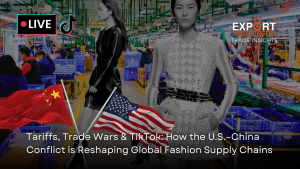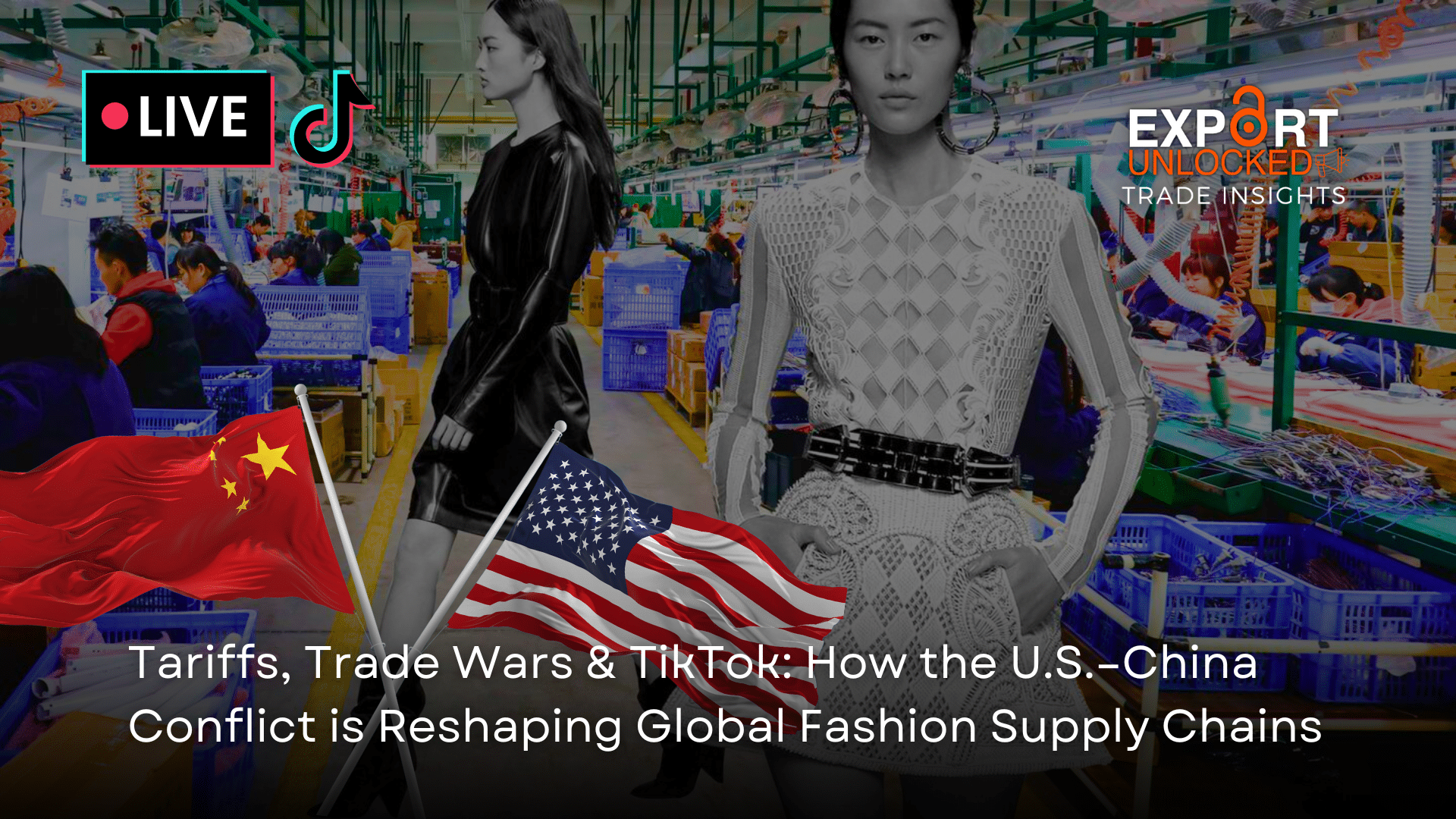

Home » Tariffs, Trade Wars & TikTok: How the U.S.–China Conflict is Reshaping Global Fashion Supply Chains
Tariffs, Trade Wars & TikTok: How the U.S.–China Conflict is Reshaping Global Fashion Supply Chains
By Export Unlocked, Megi Dervishi, 15 April 2025.
Summary: As the U.S.–China trade war intensifies in 2025, with record-high tariffs imposed on both sides, the global fashion industry faces mounting disruption. From rising production costs and shrinking margins to Chinese manufacturers bypassing traditional luxury brands via TikTok, fashion businesses must now adapt to a rapidly changing supply chain landscape. This article explores how US tariffs on China and China tariffs on US goods are reshaping sourcing strategies, digital commerce, and consumer perceptions of value, highlighting key risks, emerging trends, and strategic actions for forward-looking brands.
Why 2025 Might Be the Year the Luxury Industry Changed Forever
The global fashion industry has long operated across invisible borders, powered by complex international supply chains and discreet manufacturing partners. But in 2025, that system is facing unprecedented pressure.
A new wave of trade restrictions, most notably US tariffs on China and China tariffs on US goods, is disrupting the flow of materials, reshaping sourcing strategies, and altering consumer perception of luxury.
Meanwhile, a digital trend is unfolding that no brand can afford to ignore: Chinese manufacturers are using TikTok and other platforms to cut out the middleman, exposing where luxury products are really made and offering them direct to consumers.
🇺🇸 US Tariffs on China: What’s Changing?
In a bold policy shift, the U.S. has imposed:
- Up to 145% tariffs on Chinese imports across electronics, apparel, and consumer goods.
- A baseline 10% tariff on all imports, with additional surcharges for countries with trade surpluses.
These US tariffs on China are driving up manufacturing costs, causing shipment delays, and putting significant strain on American importers, especially in the fashion sector.
🇨🇳 China’s Response: Tariffs and TikTok
In retaliation, China tariffs on US goods have reached 125%, directly targeting industries such as textiles, agriculture, and consumer electronics. While trade flows between the two powers slow, Chinese suppliers are adapting fast and going global, digitally.
On platforms like TikTok, factory owners are:
- Showcasing luxury-style handbags and fashion items.
- Claiming the same products are made in factories that supply global brands.
- Offering these goods directly to international consumers, often at a fraction of luxury retail prices.
This new model of direct-to-consumer manufacturing is quickly gaining traction, particularly among Gen Z and Millennial shoppers who prioritize transparency and affordability.
How This Affects Global Fashion
- Luxury Sales Down: LVMH reported a 5% decline in fashion/leather goods in Q1 2025, citing slowing demand in China and the U.S.
- Fast Fashion Under Pressure: Brands like Shein are facing higher costs due to the end of tax exemptions on low-cost Chinese exports.
- Small Brands Hit Hard: U.S.-based fashion startups are halting operations due to insurmountable costs tied to the new tariffs on Chinese imports.
International Responses
🇮🇪 Ireland
Actively expanding trade relationships with Canada, India, Japan, and the UAE — a strategic hedge against heavy U.S. market reliance.
🇬🇧 United Kingdom
UK Chancellor Rachel Reeves is calling for international resistance to protectionism, urging a return to open global trade and stable markets.
🇨🇳 China
In addition to tariffs, China is turning to its domestic economy and enabling exporters to build independent consumer channels through e-commerce and content platforms.
Strategic Priorities for Fashion & Retail Brands
- Reevaluate Sourcing: Look beyond China to mitigate exposure to US tariffs on China and political risk.
- Double Down on Transparency: Customers are increasingly aware of how and where goods are made. Brand trust will depend on openness.
- Prepare for Factory-Direct Competition: If your supplier can sell direct to your customer, how will you justify your markup?
- Monitor Policy Changes: The trade landscape is shifting weekly. Staying ahead of the new China tariff on US goods will be critical to resilience.
Final Thoughts: A Defining Moment for Global Trade & Fashion
The 2025 global trade war has morphed from a political conflict into a commercial transformation. What started as a series of US tariffs on China and reciprocal China tariffs on US goods is now accelerating a deeper shift, where transparency, technology, and speed to market are redefining what consumers expect from brands.
For the fashion industry, this may be the year that the traditional rules, built on secrecy and brand prestige, begin to fall away.
|Because in today’s market, the factory isn’t just behind the scenes. It’s on camera. And it’s selling direct.
Are you seeing changes in your industry due to the trade war?
- Is your brand rethinking sourcing?
- Are you feeling pressure from factory-direct competitors?
- How do you plan to maintain value in a market where the supply chain is no longer hidden?
Let’s continue the conversation below or book a call for support from us!
Book a call here
Enjoyed our articles? Our subscribers are the first to receive trade insights weekly! Be the first to access all updates by joining the Export Unlocked community – Join here
Discover More Articles:


UK–EU Trade Alignment Becomes Critical Amid Rising Global Tariffs

